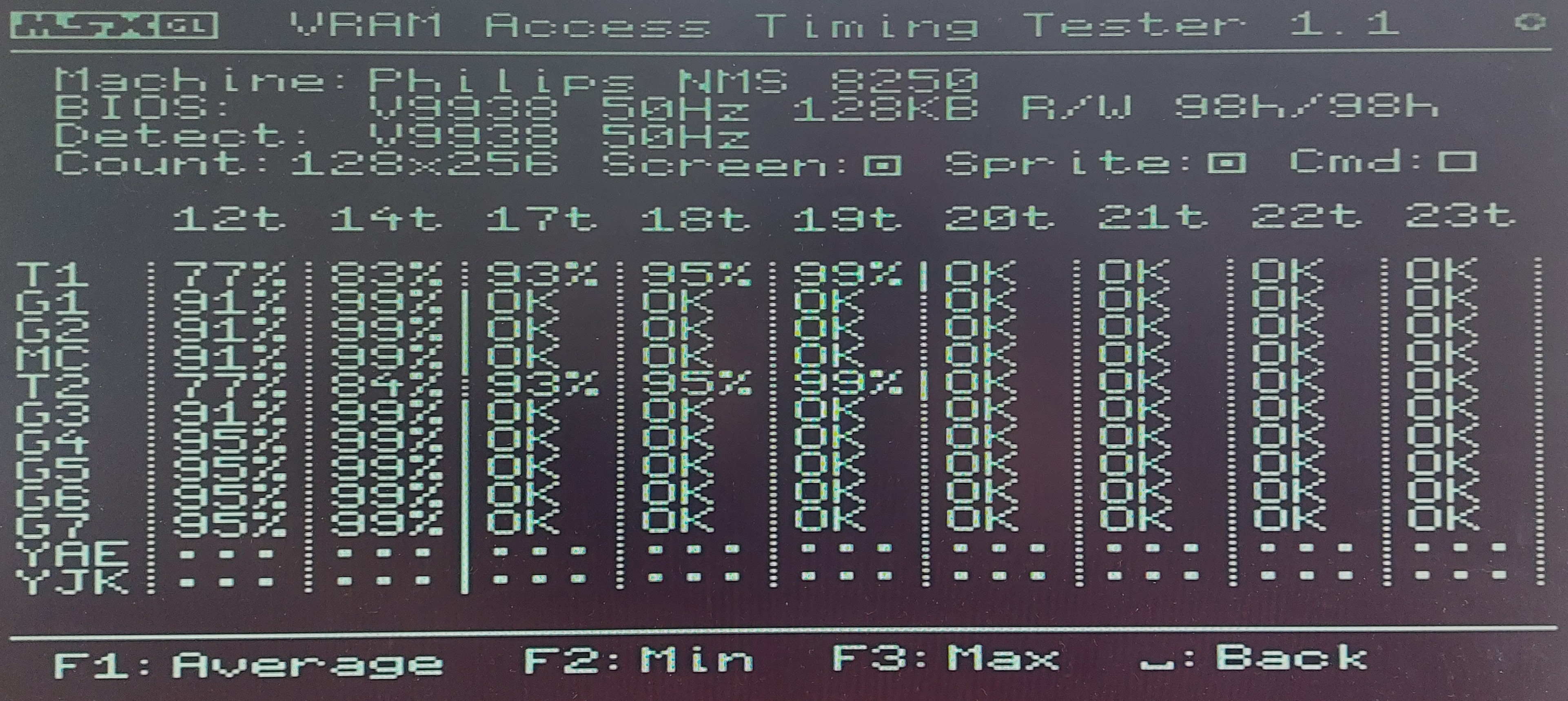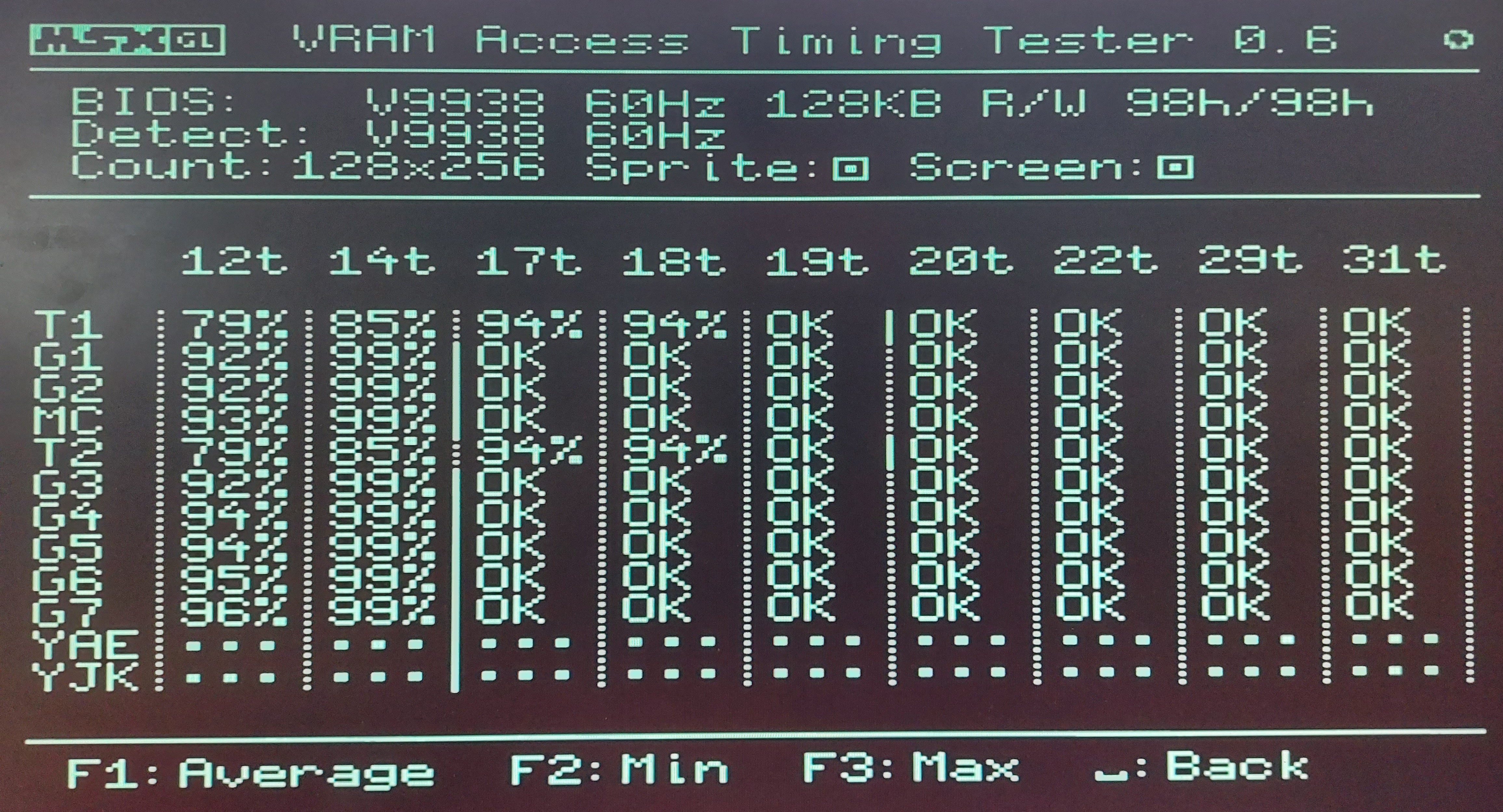VRAM access timing
From MSX Game Library
As MSXGL intends to offer the best possible performance to MSX game creators, special attention has been paid to ensure the highest possible speed when accessing the VRAM. But, MSX hardware is so made that it is sometimes possible (depending on the context) to write or read too quickly in the VDP memory and thus to create data corruptions. To create the VDP module we based our VRAM access times on the information available on the net and in particular on the site MSX Assembly Page and its articles which are references in this field:
The last article gives a table of possible access times for each screen mode for each VDP generation. Thus, the VDP module of MSXgl automatically adjusts its access times to the screen modes chosen in the library configuration (msxgl_config.h) to allow the best possible access times while ensuring the proper functioning of the application even in the worst case scenario.
The problem is that in some situations, we could observe data corruption in a context where the given access times were respected. A tool was then created to verify these theoretical access times with concrete test cases: VATT (for VRAM Access Timing Tester).
The results of these tests showed that the reference data had some limitations. Notably a wrong access time for Screen Mode 3 on MSX1 (TMS9918) or an unexpected effect with screen disabling for non-bitmap modes on MSX2 (V9938/58). These results have yet to be confirmed with other tests, but they have highlighted worst-case scenarios that we need to consider.
The VATT tool highlighted that access times depend on:
- The generation of the VDP,
- The selected screen mode,
- The activation of the screen display,
- The activation of the sprite display (V9938/58),
- The execution of VDP commands in parallel (V9938/58).
Contents
Results
Here are the revised versions of the reference table of maximum VRAM access speeds (in number of T-States) according to the screen mode and VDP generation.
In green, the revised parts.
Default
The default condition is when Screen display is activated. On MSX2 or above, the Sprite display is also activated.
| VDP mode | Screen mode | TMS9918 | V9938/58 |
|---|---|---|---|
| Text 1 | Screen 0, Width 40 | 12 | 20 |
| Graphic 1 | Screen 1 | 29 | 15 |
| Graphic 2 | Screen 2 | 29 | 15 |
| Multicolor | Screen 3 | 29 | 15 |
| Text 2 | Screen 0, Width 80 | -- | 20 |
| Graphic 3 | Screen 4 | -- | 15 |
| Graphic 4 | Screen 5 | -- | 15 |
| Graphic 5 | Screen 6 | -- | 15 |
| Graphic 6 | Screen 7 | -- | 15 |
| Graphic 7 | Screen 8 | -- | 15 |
No screen display
Maximum access speed when Screen display is disable.
| VDP mode | Screen mode | TMS9918 | V9938/58 |
|---|---|---|---|
| Text 1 | Screen 0, Width 40 | 12 | 20 |
| Graphic 1 | Screen 1 | 12 | 15 |
| Graphic 2 | Screen 2 | 12 | 15 |
| Multicolor | Screen 3 | 12 | 15 |
| Text 2 | Screen 0, Width 80 | -- | 20 |
| Graphic 3 | Screen 4 | -- | 15 |
| Graphic 4 | Screen 5 | -- | 12 |
| Graphic 5 | Screen 6 | -- | 12 |
| Graphic 6 | Screen 7 | -- | 12 |
| Graphic 7 | Screen 8 | -- | 12 |
No sprite display (V9938/58)
Maximum access speed when Screen display is enable but Sprite display is disable.
| VDP mode | Screen mode | TMS9918 | V9938/58 |
|---|---|---|---|
| Text 1 | Screen 0, Width 40 | -- | 20 |
| Graphic 1 | Screen 1 | -- | 15 |
| Graphic 2 | Screen 2 | -- | 15 |
| Multicolor | Screen 3 | -- | 15 |
| Text 2 | Screen 0, Width 80 | -- | 20 |
| Graphic 3 | Screen 4 | -- | 15 |
| Graphic 4 | Screen 5 | -- | 14 |
| Graphic 5 | Screen 6 | -- | 14 |
| Graphic 6 | Screen 7 | -- | 14 |
| Graphic 7 | Screen 8 | -- | 14 |
These results are yet to be confirmed (some machines may have worse cases that invalidate these results). We therefore do not recommend (for the moment) taking advantage of these better access times when sprites are disabled.
VDP command (V9938/58)
Running VDP command don't really have impact on maximal speed of direct access to VRAM but can generate glitches. Tests have shown that this happens when the command work on the same VRAM area than the direct access do. In this case, and only in this case, direct access can failed and VRAM can be corrupted (presumably by command malfunction).
When you load data into VRAM it is therefore recommended that you do not run any VDP commands in parallel, or at least never on the same VRAM area.
If you have previously started commands on this VRAM area and you are not sure if they are finished, it is recommended to use the VDP_CommandWait() function before starting direct access to that area.
Emulation
openMSX
openMSX (18.0) supports VRAM access time emulation with the following limitations:
- In the default mode (display and sprites enable), it is a little too optimistic, i.e. within about 1~2 t-states, accesses that will work on openMSX will not work on a real machine. For example, on a Philips NMS 8250, an access with an interval of 19 t-states will work on openMSX but may fail on a real machine.
- With display disabled, it does not emulate at all the access time limitations of the non-bitmap display modes on V9938/58. This can be a major source of error, as this limitation doesn't exists on TMS9918 and don't seem to be documented.
- With sprites disabled, it still emulates too optimistically, sometimes with a 3 t-state gap between valid intervals in openMSX and those observed on a real machine. For example, while an access in graphics mode 1 with an interval of 12 t-states is valid in openMSX, it requires at least 15 t-states on a real machine.
Emulicious
Emulicious (2023-04-22) has a limited emulation of VRAM access time:
- On TMS9918, a limitation exists for the default mode (display enabled) but it does not correspond to the value observed on a real machine. All screen modes seem to have an access limit of 25 t-states, whereas valid intervals are supposed to be 12 t-states for Text 1 mode and 29 for the others.
- On the other hand, with the screen off, access times are correct.
- On V9938/58, no limitation seems to be emulated at all.
Others
Other emulators do not emulate VDP access timing constraints at all: fMSX (6.0), blueMSX (2.8.2), MEISEI (1.3.2) and RuMSX (0.83).
Annexes
Testing protocol
The VATT tool uses the following technique to validate that accessing the VRAM at a given speed is safe or not with the selected Screen mode:
- Setup test condition (Screen mode, Screen display enable/disable, etc.).
- Write slowly (with 31 t-states between each write) a sequence of 256 characters which are used to initialize the VRAM.
- Write 256 times a control character with the speed function we want to test (from a 12 to 31 t-states write interval).
- Read slowly the 256 characters and count the number of times the control character is present.
- Repeat these steps N times (between 1 and 128) and calculate an average, a minimum and a maximum.
If the average is not 100 (displayed as "OK") it means that there was at least one access miss among all the iterations. Therefore, this access speed is not safe for the tested context.
Some examples:
 Philips NMS8250 |
 Panasonic FS-A1 |
Reference machines
Result founded with VATT have been confirmed on those machines:
| Machine | BIOS | VDP | Region | Misc. |
|---|---|---|---|---|
| Casio PV-7 | MSX1 | Texas Instruments TMS9118NL | NTSC | |
| Panasonic FS-A1 | MSX2 | Yamaha V9938 | NTSC | |
| Panasonic FS-A1FX | MSX2+ | Yamaha V9958 | NTSC | I/O +2 t-states |
| Panasonic FS-A1GT | MSX turbo R | Yamaha V9958 | NTSC | I/O +1 t-state |
| Philips NMS 8245 (modded) | MSX2 | Yamaha V9958 | PAL | |
| Philips NMS 8250 | MSX2 | Yamaha V9938 | PAL | |
| Sony HB-75P | MSX1 | Texas Instruments TMS9929A | PAL | |
| Sony HB-F1XD | MSX2 | Yamaha V9938 | NTSC | |
| Victor HC-30 | MSX1 | Yamaha YM2220 | NTSC | |
| Yamaha CX5MII | MSX1 | Yamaha V9938 | PAL |